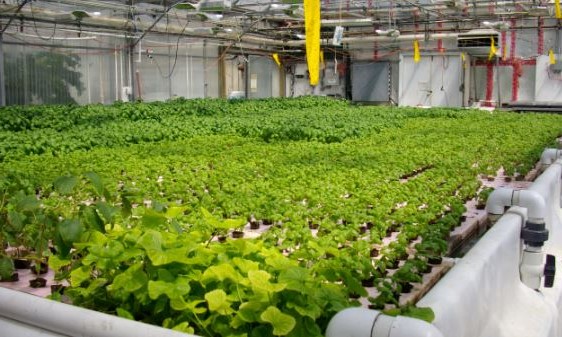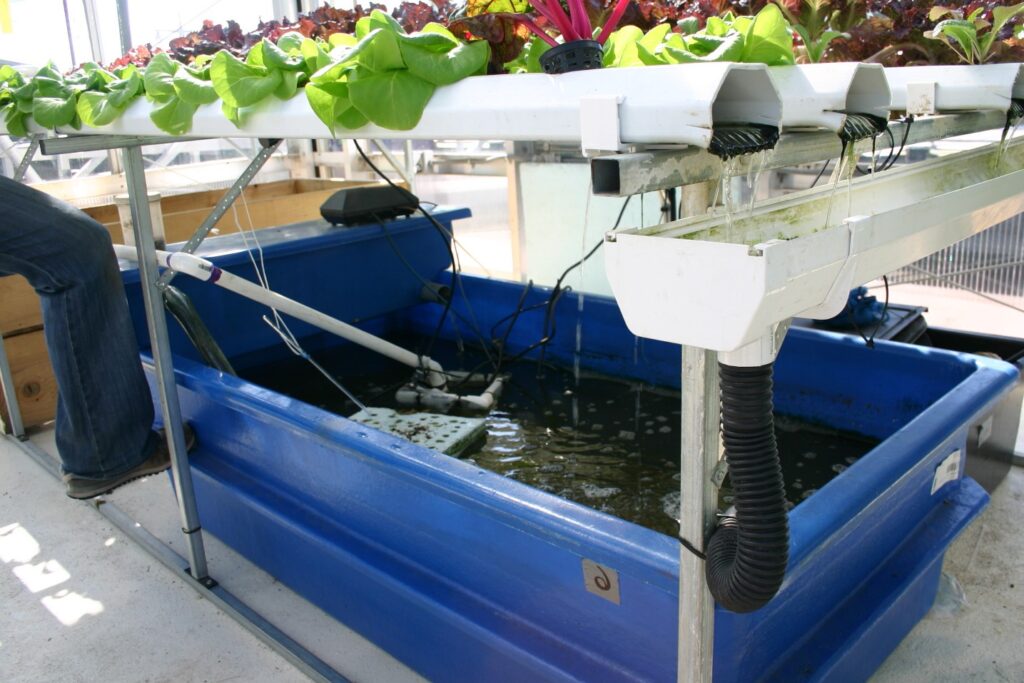Today, let us differ the Aquaponics farming system, the types, and components of the system, advantages, and disadvantages. This farming system actually connects aquaculture and hydroponics to produce vegetable crops.
Aquaponics Farm depends on the nutrients which are produced by the interaction of freshwater plants and fish as they create a connection of synergetic in a maintained surrounding.
Also, read about vertical farming.
Aquaponics Farm System is ecologically friendly. It is a genuine food-growing technique. In this farming system, fish and plants are together constructed. This farming system is moving from the realm of experimental to commercial. Learn more about this production system.

What Is Aquaponics?
Many of us even don’t know what is aquaponics? In the word “Aquaponics”, where “Aqua” refers to raising fish in stable circumstances, and “Ponics” is a word for hydroponics which refers to growing plants in a soil-less media. It is excellent compost for growing plants.
Today, this farming system is being used in a number of countries. This farming system hasn’t been stretched on a large-scale commercial basis. One of the most casual specialties is that it imitates a natural ecosystem.
Aquaponics meaning is a system of agriculture that creates a connection between water, nutrient motion, bacteria, plants, and aquatic life. All of these are grown together in waterways all over the world. Various spices such as green leafy like spinach, okra, lettuce, and basil flourish in an aquaponic system.
How Does An Aquaponics System Work?
Aquaponics is the successful combination of hydroponics and aquaculture into one production system which forms a self-pleasing and sustainable ecosystem that can be gathered like a grange. In this farming system, fish eat the food and release trash which is transformed by useful bacteria into nutrients. plants can use these nutrients. And these nutrients plants help to clarify the water.
Thereafter, the ammonia-rich water flows from the fish tank into a biofilter with un-eaten food and decaying plant matter together. After that, bacteria break everything down into organic nutrient solutions inside the biofilter, just for growing vegetables.
Aquaponic freshwater systems include three main components- freshwater fish, nitrifying bacteria, and plants, they depend on each other to survive. Without bacteria, plants wouldn’t have the functional form of nutrients to eradicate the fish waste either, which is why natural filtration is crucial. Thanks to the plant growth as nutrients are released from the water and exiting it to clean for the fish.

Types Of The Aquaponic System:
There are three types of aquaponic farms– media beds, nutrient film technique, and deep water culture. These are not the only three designs though, they are the most common.
1. Media Beds:
The media bed form uses containers loaded with rock media. The rock media actually help to keep the roots of plants. The media bed is exhausted of high-nutrient water to give the plants nutrients and oxygen. This method is used for beginners and gardeners because it doesn’t need plant science experience to work well. It is an affordable way. It is simple to put together and shape at a small scale.
With this technique, you are able to make large root mass plants such as fruits and root vegetables. It is great for a smaller-scale process but is tough to scale for large production. The media bed method needs more cleaning. It needs more increased care and labor.
2. Nutrient Film Technique:
Having area organization and lower labor costs, the nutrient film technique is a popular method in the saleable industry. With this method, crops can also be cultivated on steep land. Crops are smoothly harvestable and reasonable.
However, this method is best worked for lush greens with the most popular hydroponic production. Plants are continuously supplied with the water, nutrients, and oxygen how much they need. The method is easy to approach and needs lower labor.
But this method is not supported for the large rooted crops as their poundage may not be kept and the masses may block the drain.
3. Deep Water Culture:
The Deepwater system is the most long-lasting of these three systems. The method is best worked for more sociable climates as it would heal daily temperature swings.
A Deepwater system is also known as a float system. This method is usually for drifting mass to break plant roots into high nutrient water. There is no media bed to capture and process solid waste. There is much more water in the system.

Components Of An Aquaponics System:
There are many elements of an aquaponic farm. Waste is formed by the fish in aquaculture tanks. However, this waste contains many nutrients that support plant growth. Plants are added to the bottom of the tank that destroys the trash from the fish and produces the food that fish can later eat. However, the instrument of a typical aquaponics system includes–
Rearing Tank– Where fish are provided and grown commercially.
Settling Basin– It captures uneaten food and separated biofilms as sinking out fine particulates.
Biofilter– Where bacteria can change into ammonia. Waste changes into various nitrates as nutrients that plants can use.
Hydroponics Subsystem– Where plants are developed from extra nutrients in the water.
Sump– It is the lowest position of the system. Water pours to the sump point and is pumped back into the system.

Advantages Of Aquaponics:
There are several advantages and disadvantages of this aquaponics farming system. The financial and environmental advantages of this system such as healthy and organic benefits, and reduced water uses are essential elements for tolerable farming.
1. Healthy & Organic Benefits:
Raising food in an aquaponic garden is refreshed, more nutritious, and genuinely organic. Fish and plants are not infected with biopesticides. In this farming system, everything used to produce fruits and vegetable plants is natural and chemical-free.
2. Reduces Water Usage:
Water waste is significantly minimized compared to backyard gardens and commercial farms. For maintaining an aquaponic technique, water is used frequently reclaimed, and reused. There is no need for additional water as support to plant and fish growth.
3. Environmental Benefits:
The environmental benefits are the most important part of this growing system. This farming system needs very little water and very little power overall. It is a closed system. There is no waste and no pollution.
4. Chemical-Free:
It doesn’t require the use of any pesticides or any type of chemical which can make the fish sick. Not using chemicals has multiple environmental and human health benefits.
5. Climate Adaptive:
Climate adaptation is more important with a growing global population and increased food insecurity. It is truly a climate-adaptive growing method that allows producers to make adjustments and save energy.
6. Two Incomes For Commercial Aquaponics Farmers:
A larger aquaponic farming system can enjoy two types of income. The vegetables, fruits, and fish they grow can be also marketed to food manufacturers.

Disadvantages Of Aquaponics:
While there are many advantages to the aquaponics farming system, there are also some disadvantages too. The growing system can be expensive to set up. There are some requirements that may prohibit some mid-size producers.
1. It Is Costly:
The aquaponic growing system is costly to set up and maintain. Generally, the costs are mostly conditional on the aquaponic tank’s size. Depending on the type of system lodged, a commercial process can vary from $20,00 to over $100,00.
2. Some Crops Are Not Available For This Method:
Root crops are not growing in this system because they require soil to grow. Assuming more nutrients and water, big crops are also tough to produce using this method. Also, some fish including largemouth bass, yellow perch, salmon, and trout are not suggested for this growing system.
3. It Needs To Be Lodged Professionally:
Setting up and lodging the growing system needs professional ability and experience. The care should be done professionally as there may be the risk of losses in maintaining the plants.
4. It Ruins A Lot Of Electricity:
The growing system may help to save land and water use. But it balanced with its electricity use. It may not need a huge amount of energy but the energy needed is important.
5. There’s A Risk Of Random Failure:
Aquaponics is regarded as an involved process as you have to near observe the plants and the fish too. Fishes may not be able to stay if there are changes in their living circumstances. Also, the plants run the risk of acquiring diseases.

How is aquaponics farm profitable in India?
The aquaponics system can be very profitable in India. In India, growing crops in the area is a big deal due to pests, rain lack, and chemical medicine used in the farming method. People also search for Aquaponics India to know the setting up costs. Depending on the type of system lodged, a commercial process can vary from $20,00 to over $100,00.
Conclusion:
As an endurable meaning of farming, Aquaponics is always achieving worldwide renowned. This method highlights a connection between aquatic animals and plants, which constructs it as an adorable food source and livelihood for households and communities.
It can help to improve food guards and food authority. This method is easy to run and uses much less water than standard farming. It is overall the best explanation to feed the world.
FAQs:
Q. What is aquaponics?
Aquaponics is a system of aquaculture in which the thrush is produced by aquatic creatures such as fishes that supplies the nutrients for growing the plants.
Q. How much does it cost to start the method?
The inexact cost of setting up an aquaponic system varies between 5 to 10 lakh.
Q. Is aquaponics better than hydroponics?
Many people believe that aquaponics is better than hydroponics when selecting a soilless growing method. But both farming systems have apparent advantages over soil-based farming.
Q. Can aquaponics be profitable?
A commercial aquaponics technique can be profitable when it has done on a specific scale.
Q. What is the most profitable fish to farm?
Tilapia is becoming the most profitable fish to farm in the aquaponic method.
Q. What plants are best for the aquaponic farm?
Plants like leafy lettuce, basil, tomatoes, peppers, and cucumbers are best for the aquaponic farm.
